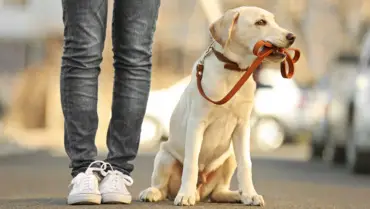Are you a new dog owner or struggling with getting your furry friend to behave at home? Well, look no further! Crate training is a powerful tool that can benefit both you and your pup in many ways.
Whether it’s helping with potty training or providing a safe space for your dog to rest and relax, crate training has countless advantages. In this blog post, we’ll explore the benefits of crate training and how it can positively impact both you and your four-legged companion.
So buckle up and get ready to learn more about the amazing benefits of embracing crate training for you and your beloved pet!
What is Crate Training?
Crate training is a process of teaching your dog to feel comfortable and safe in an enclosed space. It is an effective way to help your dog become accustomed to living in close quarters with people and other animals, and can be particularly helpful if you have a new puppy or adopted dog.
Crate training can also be used as a tool to help manage your dog’s behavior, such as curbing separation anxiety or reducing disruptive barking.
When crate training, it is important to take things slowly and give your dog plenty of positive reinforcement. Start by feeding your dog its meals in the crate, then gradually increase the amount of time it spends in the crate until it is comfortable spending several hours there at a time. Once your dog is acclimated to the crate, you can begin using it for short periods of time when you leave the house or when guests come over.
Crate training takes patience and consistency, but the effort is well worth it for both you and your dog. Crate-trained dogs are less likely to develop separation anxiety or other behavior problems, and are easier to travel with and board at kennels or vet offices. If you are thinking about crate training your dog, talk to your veterinarian or animal behaviorist for more information and guidance.
Benefits of Crate Training
There are many benefits of crate training for both you and your dog. Crate training can help your dog to feel more comfortable and secure in their environment, and can make it easier for you to travel with your dog or leave them at home while you go out.
Crate training can help to:
– Potty train your dog
– Keep your dog from chewing on furniture or other household items
– Protect your dog from hazards in the home
– Keep your dog from running away if they get loose
– Give your dog a safe space to stay when they are feeling anxious or stressed
– Help socialize shy or timid dogs
How to Successfully Implement Crate Training
Introducing your dog to a crate can be a successful and rewarding experience for both you and your pet. Crate training is an excellent way to help your furry friend feel comfortable and secure in their new home, and can also be a useful tool for house-training. Follow these tips to crate train your dog successfully:
1. Choose the right size crate. It should be big enough for them to stand up and turn around in, but not so large that they can use one end as a bathroom. If you have a puppy, consider getting a divider panel to adjust the size of the crate as they grow.
2. Put the crate in a safe, quiet place where they can feel relaxed. Their crate should be somewhere they feel comfortable spending time, away from any loud noises or commotion.
3. Introduce them to the crate gradually. Start by simply placing treats or their favorite toy inside the crate, letting them approach at their own pace. Once they’re comfortable going inside, you can try closing the door for short periods of time while staying nearby. Slowly increase the length of time that the door is closed as they get used to being in there.
4. Never use the crate as punishment; this will only make them associate it with negative feelings. Instead, focus on making it a happy experience by offering praise and rewards when they go inside willingly.
With patience and positive reinforcement, you can help your dog learn to love their crate
Types of Crates
There are many different types of crates that you can choose from for your dog, depending on their individual needs and your own personal preferences. Some common types of crates include plastic crates, wire crates, soft-sided crates, and collapsible crates.
Plastic crates are a popular choice for many dog owners because they are sturdy and easy to clean. They also come in a variety of sizes to fit any dog, from small to large. Wire crates are also strong and durable, but they provide more visibility and ventilation for your dog than a plastic crate.
Soft-sided crates are a good option for dogs that are calm and quiet, as they are not as sturdy as the other types of crates. Collapsible crates are convenient if you need to move them around or travel with them, as they can be easily collapsed and packed away.
No matter which type of crate you choose, make sure that it is the right size for your dog and that it has plenty of ventilation. Your dog should also have enough room to stand up and turn around inside the crate.
Establishing a Routine
Crate training can be an extremely beneficial tool for both you and your dog. A crate can provide a safe, secure place for your dog to stay while you are away from home or if there is a problem with house-training. Crate training can also help to establish a routine for your dog, which can make life much easier for both of you.
When done correctly, crate training is a humane way to teach your dog boundaries and help them learn to become comfortable in their own space. It is important to remember that a crate should never be used as punishment; rather, it should be seen as a positive experience for your dog. With that in mind, here are some tips on how to get started with crate training:
1) Choose the right size crate for your dog. It should be large enough for them to stand up, turn around, and lie down comfortably, but not so large that they can use one end as a bathroom.
2) Place the crate in an area of the house where your family spends a lot of time, such as the living room or kitchen. This will help your dog feel like they are part of the family and not isolated in a separate room.
3) Put something soft and comfortable inside the crate, such as a blanket or towel. This will give your dog a cozy place to rest.
4) Introduce your dog to the crate gradually by leaving the door open and encouraging them to go inside on
Alternatives to Crate Training
Crate training is not the only option for dog owners. There are a number of other options available that may be better suited for you and your dog. Some alternatives to crate training include:
1. Puppy playpens: These are enclosed areas where puppies can play and explore safely. They are often made from mesh or metal panels and have a removable bottom for easy cleaning. Many playpens can also be converted into temporary crates if needed.
2. Dog gates: These can be used to block off areas of your home that you do not want your dog to have access to. They come in a variety of materials, including wood, plastic, and metal, and can be either freestanding or mounted to walls.
3. Exercise pens: These are similar to puppy playpens but are larger and designed for older dogs. They provide an enclosed area where dogs can run and play without the risk of escaping or getting lost.
4. Dog Amber Alert GPS locators: These devices attach to your dog’s collar and use GPS technology to track their location at all times. This can give you peace of mind if your dog ever gets loose from their enclosure or yard.
Conclusion
Crate training is a great way to create a safe and comfortable space for your canine companion. Not only will it help them feel less stressed during long trips, but it can also provide you with peace of mind knowing that they are secure when left alone at home.
While crate training may seem intimidating at first, the benefits far outweigh any time or effort put in. With patience and consistency, you’ll be sure to form an everlasting bond with your pup that comes from teaching and reinforcing good behavior through positive reinforcement.





Add Comment